Pink Floyd | ||
| Allmusic Biography : Some bands turn into shorthand for a certain sound or style, and Pink Floyd belongs among that elite group. The very name connotes something specific: an elastic, echoing, mind-bending sound that evokes the chasms of space. Pink Floyd grounded that limitless sound with exacting explorations of mundane matters of ego, mind, memory, and heart, touching upon madness, alienation, narcissism, and society on their concept albums of the 70s. Of these concept albums, Dark Side of the Moon resonated strongest, earning new audiences year after year, decade after decade, and its longevity makes sense. That 1973 album distilled the wild psychedelia of their early years -- that brief, heady period when they were fronted by Syd Barrett -- into a slow, sculpted, widescreen epic masterminded by Roger Waters, the bassist who was the bands de facto leader in the 70s. Waters fueled the bands golden years, conceiving such epics as Wish You Were Here and The Wall, but the band survived his departure in the 80s, with guitarist David Gilmour stepping to the forefront on A Momentary Lapse of Reason and The Division Bell. Throughout the years, drummer Nick Mason and keyboardist Rick Wright appeared in some capacity, and the bands sonic signature was always evident: a wide, expansive sound that was instantly recognizable as their own, yet was adopted by all manner of bands, from guitar-worshiping metalheads to freaky, hippie, ambient electronic duos. Unlike almost any of their peers, Pink Floyd played to both sides of the aisle: they were rooted in the blues but their heart belonged to the future, a dichotomy that made them a quintessentially modern 20th century band. That blues influence, quickly sublimated and only surfacing on the occasional Gilmour guitar solo, was the foundation for the bands very name, as the group decided to splice the names of two old bluesmen -- Pink Anderson and Floyd Council -- as a tribute to the American music they loved. These members of the early Floyd -- guitarist/singer Syd Barrett, bassist Roger Waters, keyboardist Rick Wright, and drummer Nick Mason -- were all architecture students at London Polytechnic, with the exception of Barrett, who was an art student and a friend of Waters since childhood. This version of the band started gigging regularly in 1965, with Barrett becoming the groups lead singer quite quickly. During this time, the group relied on blues and R&B; covers, not unlike many of their British peers, but they wound up extending the time of their sets through extended instrumental jams, planting the seeds of space rock that would come to fruition not much later. In 1966, the groups increasingly adventurous sets became something of a sensation in the London underground, leading to a contract with EMI early in 1967. Their first single, "Arnold Layne," backed with "Candy and a Currant Bun," appeared in March of 1967, and it was banned from some radio stations due to its gender-bending lyrics, but the single wound up in the U.K. Top 20, and the groups second single, "See Emily Play" -- a menacing, mincing stomp with a profound, lasting influence -- went into the Top Ten, paving the way for the release of The Piper at the Gates of Dawn. On their full-length LP, Pink Floyd veered toward the experimental and avant-garde, particularly on the elastic, largely instrumental vamps "Astronomy Domine" and "Interstellar Overdrive," resulting in an album that had a significant influence not only upon its release but well beyond. It was also a hit in the U.K., reaching number six on the British charts. This was a sudden rush to stardom and complications arose nearly as quickly. Not long after the release of Piper, Barrett began showing clear signs of mental illness, to the point he would often freeze on-stage, not playing a note. At this point, David Gilmour -- a friend and associate of the band -- was brought in as a second guitarist, with the intention that hed buttress the groups live performances while Barrett continued to write and record new material. This soon proved to be an impossible situation, and Barrett left the group, at which point the bands management also jumped ship, leaving them without any kind of leader. In the wake of Barretts departure, the remaining members of Pink Floyd developed a different musical identity, one that was expansive and eerie, characterized by the bands spacy, somber explorations and, eventually, Waters cutting, sardonic lyrics. This transition took some time. In 1968, they released A Saucerful of Secrets, which contained Barretts final composition for the group, "Jugband Blues," and it found the group moving forward, particularly on the instrumental sections. A Saucerful of Secrets also saw the group begin a long, fruitful collaboration with Storm Thorgersons design team Hipgnosis; theyd wind up designing many iconic album covers for the band, including Dark Side of the Moon and Wish You Were Here. Hipgnosis emphasized album art, and albums are where Pink Floyd concentrated from this point forward. After the soundtrack to More, the group moved to EMIs progressive rock imprint Harvest and became the labels flagship artist beginning with the 1969 double-LP Ummagumma. Divided between live performances and experimental compositions from each member, the record wound up in the Top Ten in Britain and sowed the seeds of a cult following in the United States. Pink Floyds next album, Atom Heart Mother, featured extensive contributions from composer Ron Geesin and wound up as the bands first number one album in the U.K. The band embarked on an extensive supporting tour for the album and when they returned they delved even further into studio experimentation, learning the contours of the studio. Their next studio album, 1971s Meddle, bore the fruit of this labor, as did 1972s Obscured by Clouds, which was effectively a soundtrack to Barbet Schroeders film La Vallee. All the experiments of the early 70s were consolidated on their 1973 album Dark Side of the Moon, an album for which there simply was no precedent in their catalog. Deepening their music while sharpening their songwriting, Floyd created a complex, luxurious album with infinite space and depth. Partially helped by the single "Money," it was an immediate success, reaching number one on the U.S. Billboard charts and peaking at number two in the U.K., but what was striking was its longevity. Dark Side of the Moon found space on the Billboard charts and then it just stayed there, week after week for years -- a total of 741 weeks in all (once it finally dropped off the charts, Billboard began the Catalog charts, where Dark Side was a fixture as well). Dark Side of the Moon was a staple on classic rock radio but it also was a rite of passage, an album passed down to teenagers when they were turning to serious music, and it was an album that stayed with listeners as they aged. Now established superstars, Pink Floyd dug deep on Wish You Were Here, their 1975 sequel to Dark Side of the Moon, which functioned as an album-long tribute to Syd Barrett. Compared to Dark Side, Wish You Were Here wasnt quite a blockbuster but it was certainly a hit, debuting at number one in the U.K. and reaching that peak in the U.S. as well. Floyd continued to tour steadily, often working out new material on the road. This is particularly true of 1977s Animals, which had its roots in several songs aired during the 1975 tour. During the Animals tour, Waters had a difficult experience with a Montreal crowd where he spit on a heckler, and he used this incident as the genesis for 1979s rock opera The Wall. Co-produced by Bob Ezrin, The Wall may be Floyds most ambitious album, telling a semi-autobiographical story about a damaged rock star, and its one of the bands most successful records, topping the charts throughout the 80s and turning into a pop music perennial along the lines of Dark Side. Part of its success in 1980 was due to "Another Brick in the Wall, Pt. 2," where an instrumental motif from the album was given a disco beat and an anti-authoritarian spin, leading to a genuine number one hit single from the band. Certainly, the single had more to do with the albums success than the live production of the album, as Pink Floyd only did a handful of dates in major cities. Nevertheless, these shows, consisting of a wall being built across the stage during the first act and the band performing behind it during the second, were legendary (Waters would revive and update the production years later to great success). Pink Floyd did attempt to film The Wall for a documentary film, but the footage was botched, so they decided to pursue a feature film directed by Alan Parker and featuring Boomtown Rat Bob Geldof in the lead role. The Wall arrived in theaters in 1982 and turned into a midnight movie staple. A year later, The Final Cut -- a further autobiographical work from Waters, its title a sly dig to his battles with Parker on the film -- arrived, but it didnt come close to matching the chart success of any of its predecessors. Behind the scenes, things were tense. Rick Wright had been fired during the making of The Wall -- he was hired as a contract player during the recording and tour -- and Waters split after the release of The Final Cut, assuming that it was the end of the band. Waters released his debut solo album, The Pros and Cons of Hitchhiking -- a piece that was pitched to Floyd in 1978, but the band chose The Wall instead -- in 1984, and not long afterward, Gilmour and Mason indicated they intended to carry on as Pink Floyd, so the bassist sued the duo for the rights to the Pink Floyd name. Waters lost and Pink Floyd released A Momentary Lapse of Reason in 1987, just months after Waters released his own Radio KAOS. Bad blood was evident -- T-shirts on Waters tour bore the question, "Which Ones Pink?," an old lyric that now had greater resonance -- but Pink Floyd emerged victorious, as A Momentary Lapse of Reason turned into an international hit, and racked up some hit singles, including "Learning to Fly," which was supported by the bands first music video. Most importantly, the band racked up significant box office returns on tour, playing to sold-out stadiums across the globe. This tour was documented on the Delicate Sound of Thunder live album. The success of A Momentary Lapse of Reason allowed Pink Floyd to dictate their own schedule and they took their time to return with a new album, eventually emerging in 1994 with The Division Bell. Greeted by warmer reviews than its predecessor, The Division Bell was another international success, and the accompanying tour -- which featured a performance of the entirety of The Dark Side of the Moon -- was a smash success. As before, the tour was documented with a live album -- this one was called Pulse, packaged in eye-catching artwork with a pulsing LED light -- and it performed respectably. After that, Pink Floyd went into effective retirement. The group was inducted into the Rock and Roll Hall of Fame in 1996, while Gilmour released some solo albums, including the acclaimed On an Island, but most of their efforts were devoted to managing their catalog. Long a beloved band of audiophiles, Floyd saw their catalog boxed and remastered several times, including 5.1 mixes on SACD in the early 2000s. As the new millennium progressed, a détente arose between the Floyd and Waters camps, culminating in an unexpected reunion of the original lineup of Waters, Gilmour, Mason, and Wright at the 2005 charity concert Live 8. The reunion was a rousing success, sparking rumors of a more permanent arrangement, but Gilmour declined. Instead, Waters ramped up his touring -- he performed Dark Side in its entirety, then turned his attention to The Wall, touring that for years. Gilmour and Mason wound up appearing at a 2011 show in London, signaling that there was no ill will between the members. Barrett passed in 2006 from cancer and, in 2008, Wright also died from the disease. In 2011, Pink Floyd launched an ambitious reissue project called Why Pink Floyd…? spearheaded by multi-disc, rarity-laden box set reissues of Dark Side of the Moon, Wish You Were Here, and The Wall; newly released exclusives included the original Alan Parsons mix of Dark Side, heavily bootlegged live tracks like "Raving and Drooling," and demos. Three years later, in 2014, The Division Bell was reissued to celebrate its 20th anniversary, but the bigger news was the announcement of a new album called The Endless River. Constructed using outtakes from the recording sessions for The Division Bell, the primarily instrumental album was co-produced by Gilmour, Roxy Musics Phil Manzanera, Youth, and Andy Jackson, and featured heavy contributions from the late keyboardist Rick Wright along with new work from Gilmour and Mason. The Endless River saw release in November of 2014. Two years later, Pink Floyd released the mammoth box set The Early Years 1965-1972, which combined 28 CDs, DVDs, and Blu-rays to tell a complete audio and visual picture of the bands first act; six of the boxs seven volumes were released individually in March 2017. Released alongside the box was Cre/Ation: The Early Years 1967-1972, a double-disc compilation of highlights from the set. | ||
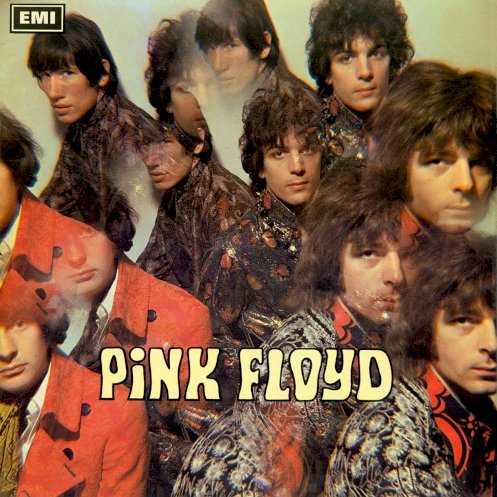 | Album: 1 of 21 Title: The Piper at the Gates of Dawn Released: 1967-07-07 Tracks: 11 Duration: 41:44 Scroll: Up Down Top Bottom 25% 50% 75% Spotify Allmusic AlbumCover | 1 Astronomy Domine (04:12) 2 Lucifer Sam (03:07) 3 Matilda Mother (03:08) 4 Flaming (02:46) 5 Pow R. Toc H. (04:26) 6 Take Up Thy Stethoscope and Walk (03:05) 7 Interstellar Overdrive (09:41) 8 The Gnome (02:02) 9 Chapter 24 (03:42) 10 The Scarecrow (02:11) 11 Bike (03:21) |
| The Piper at the Gates of Dawn : Allmusic album Review : The title of Pink Floyds debut album is taken from a chapter in Syd Barretts favorite childrens book, The Wind in the Willows, and the lyrical imagery of The Piper at the Gates of Dawn is indeed full of colorful, childlike, distinctly British whimsy, albeit filtered through the perceptive lens of LSD. Barretts catchy, melodic acid pop songs are balanced with longer, more experimental pieces showcasing the groups instrumental freak-outs, often using themes of space travel as metaphors for hallucinogenic experiences -- "Astronomy Domine" is a poppier number in this vein, but tracks like "Interstellar Overdrive" are some of the earliest forays into what has been tagged space rock. But even though Barretts lyrics and melodies are mostly playful and humorous, the bands music doesnt always bear out those sentiments -- in addition to Rick Wrights eerie organ work, dissonance, chromaticism, weird noises, and vocal sound effects are all employed at various instances, giving the impression of chaos and confusion lurking beneath the bright surface. The Piper at the Gates of Dawn successfully captures both sides of psychedelic experimentation -- the pleasures of expanding ones mind and perception, and an underlying threat of mental disorder and even lunacy; this duality makes Piper all the more compelling in light of Barretts subsequent breakdown, and ranks it as one of the best psychedelic albums of all time. | ||
 | Album: 2 of 21 Title: A Saucerful of Secrets Released: 1968-06-29 Tracks: 7 Duration: 39:20 Scroll: Up Down Top Bottom 25% 50% 75% Spotify Allmusic AlbumCover | 1 Let There Be More Light (05:38) 2 Remember a Day (04:29) 3 Set the Controls for the Heart of the Sun (05:27) 4 Corporal Clegg (04:12) 5 A Saucerful of Secrets (11:57) 6 See‐Saw (04:36) 7 Jugband Blues (03:00) |
| A Saucerful of Secrets : Allmusic album Review : A transitional album on which the band moved from Syd Barretts relatively concise and vivid songs to spacy, ethereal material with lengthy instrumental passages. Barretts influence is still felt (he actually did manage to contribute one track, the jovial "Jugband Blues"), and much of the material retains a gentle, fairy-tale ambience. "Remember a Day" and "See Saw" are highlights; on "Set the Controls for the Heart of the Sun," "Let There Be More Light," and the lengthy instrumental title track, the band begin to map out the dark and repetitive pulses that would characterize their next few records. | ||
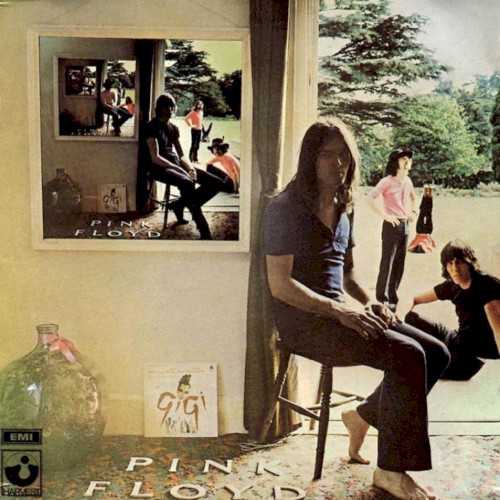 | Album: 3 of 21 Title: Ummagumma Released: 1969-10-25 Tracks: 9 Duration: 1:26:15 Scroll: Up Down Top Bottom 25% 50% 75% Spotify Allmusic AlbumCover | 1 Astronomy Domine (08:30) 2 Careful With That Axe, Eugene (08:50) 3 Set the Controls for the Heart of the Sun (09:18) 4 A Saucerful of Secrets (12:48) 1 Sysyphus, Parts 1, 2, 3, u. 4 (13:27) 2 Grantchester Meadows (07:30) 3 Several Species of Small Furry Animals Gathered Together in a Cave and Grooving With a Pict (04:47) 4 The Narrow Way, Parts 1, 2, u. 3 (12:12) 5 The Grand Vizier’s Garden Party, Part 1: Entrance / Part 2: Entertainment / Part 3: Exit (08:52) |
| Ummagumma : Allmusic album Review : For many years, this double-LP was one of the most popular albums in Pink Floyds pre-Dark Side of the Moon output, containing a live LP and a studio LP for the price of one. The live set, recorded in Birmingham and Manchester in June 1969, is limited to four numbers, all drawn from the groups first two LPs or their then-recent singles. Featuring the bands second lineup (i.e., no Syd Barrett), the set shows off a very potent group, their sound held together on-stage by Nick Masons assertive drumming and Roger Waters powerful bass work, which keep the proceedings moving no matter how spaced out the music gets. They also sound like theyve got the amplifiers to make their music count, which is more than the early band had. "Astronomy Domine," "Careful with That Axe Eugene," "Set the Controls for the Heart of the Sun," and "A Saucerful of Secrets" are all superior here to their studio originals, done longer, louder, and harder, with a real edge to the playing. The studio LP was more experimental, each member getting a certain amount of space on the record to make his own music -- Richard Wrights "Sysyphus" was a pure keyboard work, featuring various synthesizers, organs, and pianos; David Gilmours "The Narrow Way" was a three-part instrumental for acoustic and electric guitars and electronic keyboards, and Nick Masons "The Grand Viziers Garden Party" made use of a vast range of acoustic and electric percussion devices. Roger Waters "Grantchester Meadows" was a lyrical folk-like number unlike almost anything else the group ever did. | ||
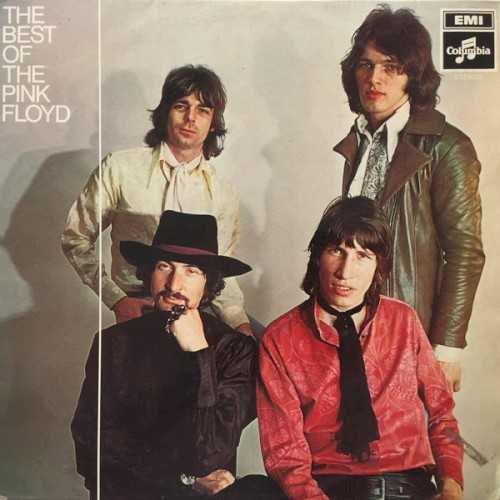 | Album: 4 of 21 Title: The Best of The Pink Floyd Released: 1970 Tracks: 10 Duration: 29:58 Scroll: Up Down Top Bottom 25% 50% 75% AlbumCover | 1 Chapter 24 (03:36) 2 Mathilda Mother (03:03) 3 Arnold Layne (02:53) 4 Candy and a Currant Bun (02:38) 5 Scarecrow (02:12) 6 Apples and Oranges (03:01) 7 It Would Be So Nice (03:39) 8 Paint Box (03:27) 9 Julia Dream (02:35) 10 See Emily Play (02:53) |
 | Album: 5 of 21 Title: Atom Heart Mother Released: 1970-10-10 Tracks: 5 Duration: 52:06 Scroll: Up Down Top Bottom 25% 50% 75% Spotify Wikipedia Allmusic AlbumCover | 1 Atom Heart Mother: a) Father’s Shout / b) Breast Milky / c) Mother Fore / d) Funky Dung / e) Mind Your Throats Please / f) Remergence (23:44) 2 If (04:30) 3 Summer ’68 (05:29) 4 Fat Old Sun (05:22) 5 Alan’s Psychedelic Breakfast: a) Rise and Shine / b) Sunny Side Up / c) Morning Glory (13:00) |
| Atom Heart Mother : Allmusic album Review : Appearing after the sprawling, unfocused double-album set Ummagumma, Atom Heart Mother may boast more focus, even a concept, yet that doesnt mean its more accessible. If anything, this is the most impenetrable album Pink Floyd released while on Harvest, which also makes it one of the most interesting of the era. Still, it may be an acquired taste even for fans, especially since it kicks off with a side-long, 23-minute extended orchestral piece that may not seem to head anywhere, but is often intriguing, more in what it suggests than what it achieves. Then, on the second side, Roger Waters, David Gilmour, and Rick Wright have a song apiece, winding up with the group composition "Alans Psychedelic Breakfast" wrapping it up. Of these, Waters begins developing the voice that made him the groups lead songwriter during their classic era with "If," while Wright has an appealingly mannered, very English psychedelic fantasia on "Summer 68," and Gilmours "Fat Old Sun" meanders quietly before ending with a guitar workout that leaves no impression. "Alans Psychedelic Breakfast," the 12-minute opus that ends the album, does the same thing, floating for several minutes before ending on a drawn-out jam that finally gets the piece moving. So, there are interesting moments scattered throughout the record, and the work that initially seems so impenetrable winds up being Atom Heart Mothers strongest moment. That it lasts an entire side illustrates that Pink Floyd was getting better with the larger picture instead of the details, since the second side just winds up falling off the tracks, no matter how many good moments there are. This lack of focus means Atom Heart Mother will largely be for cultists, but its unevenness means theres also a lot to cherish here. | ||
 | Album: 6 of 21 Title: Relics Released: 1971-05-14 Tracks: 11 Duration: 49:07 Scroll: Up Down Top Bottom 25% 50% 75% Spotify Wikipedia Allmusic AlbumCover | 1 Arnold Layne (02:53) 2 Interstellar Overdrive (09:41) 3 See Emily Play (02:53) 4 Remember a Day (04:29) 5 Paintbox (03:33) 6 Julia Dream (02:35) 7 Careful With That Axe, Eugene (05:42) 8 Cirrus Minor (05:15) 9 The Nile Song (03:24) 10 Biding My Time (05:17) 11 Bike (03:21) |
| Relics : Allmusic album Review : Since Relics is a compilation and not a regular studio album, it tends to be overlooked when thought of as one of Pink Floyds better releases. It might not be regarded as a classic psychedelic masterpiece in the manner of The Piper at the Gates of Dawn, and it certainly wont ever achieve the multiple platinum status of Dark Side of the Moon, but its a pretty good place to start with the bands early catalog. Originally issued in 1971, Relics culls from the bands first five singles (two A-sides and three B-sides, including the non-album pop classics "See Emily Play" and "Arnold Layne") and picks album material that capitalizes on the bands versatility while making it a thoroughly palatable listen. From Piper, you get the goofy childishness of "Bike" and the mesmerizing "Interstellar Overdrive," one of the bands trademark instrumental freak-outs; "The Nile Song," taken from the More soundtrack, is one of the heaviest songs the band recorded. A little bit of everything that made early Pink Floyd can be found here. Without a doubt, the disc is an essential part of the bands discography, not to be disregarded due to its overlap with studio album material. | ||
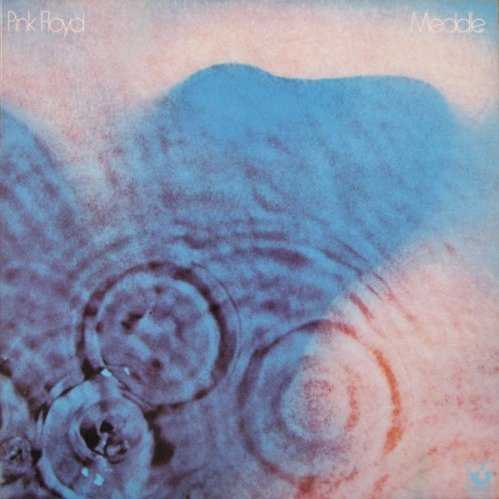 | Album: 7 of 21 Title: Meddle Released: 1971-10-30 Tracks: 6 Duration: 46:46 Scroll: Up Down Top Bottom 25% 50% 75% Spotify Wikipedia Allmusic AlbumCover | 1 One of These Days (05:56) 2 A Pillow of Winds (05:11) 3 Fearless (06:08) 4 San Tropez (03:43) 5 Seamus (02:15) 6 Echoes (23:32) |
| Meddle : Allmusic album Review : Atom Heart Mother, for all its glories, was an acquired taste, and Pink Floyd wisely decided to trim back its orchestral excesses for its follow-up, Meddle. Opening with a deliberately surging "One of These Days," Meddle spends most of its time with sonic textures and elongated compositions, most notably on its epic closer, "Echoes." If there arent pop songs in the classic sense (even on the level of the groups contributions to Ummagumma), there is a uniform tone, ranging from the pastoral "A Pillow of Winds" to "Fearless," with its insistent refrain hinting at latter-day Floyd. Pink Floyd were nothing if not masters of texture, and Meddle is one of their greatest excursions into little details, pointing the way to the measured brilliance of Dark Side of the Moon and the entire Roger Waters era. Here, David Gilmour exerts a slightly larger influence, at least based on lead vocals, but its not all sweetness and light -- even if its lilting rhythms are welcome, "San Tropez" feels out of place with the rest of Meddle. Still, the album is one of the Floyds most consistent explorations of mood, especially from their time at Harvest, and it stands as the strongest record they released between Syds departure and Dark Side. | ||
 | Album: 8 of 21 Title: The Dark Side of the Moon Released: 1973-03-24 Tracks: 10 Duration: 42:57 Scroll: Up Down Top Bottom 25% 50% 75% Spotify Wikipedia Allmusic AlbumCover | 1 Speak to Me (01:08) 2 Breathe (02:48) 3 On the Run (03:46) 4 Time (06:53) 5 The Great Gig in the Sky (04:44) 6 Money (06:22) 7 Us and Them (07:49) 8 Any Colour You Like (03:26) 9 Brain Damage (03:47) 10 Eclipse (02:11) |
| The Dark Side of the Moon : Allmusic album Review : By condensing the sonic explorations of Meddle to actual songs and adding a lush, immaculate production to their trippiest instrumental sections, Pink Floyd inadvertently designed their commercial breakthrough with Dark Side of the Moon. The primary revelation of Dark Side of the Moon is what a little focus does for the band. Roger Waters wrote a series of songs about mundane, everyday details which arent that impressive by themselves, but when given the sonic backdrop of Floyds slow, atmospheric soundscapes and carefully placed sound effects, they achieve an emotional resonance. But what gives the album true power is the subtly textured music, which evolves from ponderous, neo-psychedelic art rock to jazz fusion and blues-rock before turning back to psychedelia. Its dense with detail, but leisurely paced, creating its own dark, haunting world. Pink Floyd may have better albums than Dark Side of the Moon, but no other record defines them quite as well as this one. | ||
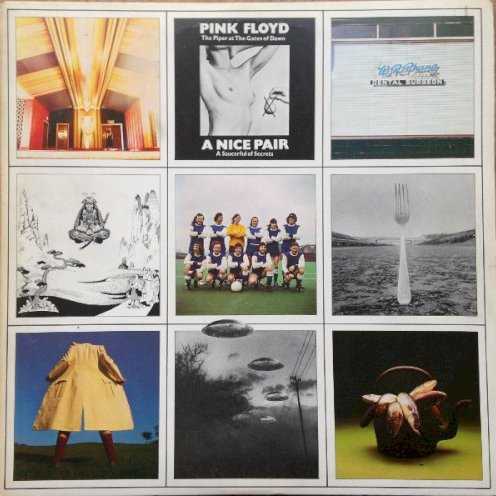 | Album: 9 of 21 Title: A Nice Pair Released: 1973-12-05 Tracks: 18 Duration: 1:21:16 Scroll: Up Down Top Bottom 25% 50% 75% Allmusic Wikipedia AlbumCover | 1 Astronomy Domine (04:12) 2 Lucifer Sam (03:07) 3 Matilda Mother (03:08) 4 Flaming (02:46) 5 Pow R. Toc H. (04:26) 6 Take Up Thy Stethoscope and Walk (03:05) 7 Interstellar Overdrive (09:41) 8 The Gnome (02:13) 9 Chapter 24 (03:42) 10 The Scarecrow (02:11) 11 Bike (03:21) 1 Let There Be More Light (05:38) 2 Remember a Day (04:29) 3 Set the Controls for the Heart of the Sun (05:27) 4 Corporal Clegg (04:12) 5 A Saucerful of Secrets (11:57) 6 See‐Saw (04:36) 7 Jugband Blues (03:00) |
| A Nice Pair : Allmusic album Review : Why the American version of this compilation of the groups highly esteemed first two LPs merits a relatively rating requires some explanation. The American version of A Nice Pair is a classic example of a good idea gone bad through the ineptitude of the people actually carrying it out. In the wake of the mega-hit status achieved earlier in 1973 by Dark Side of the Moon, executives at Capitol Records, in tandem with their counterparts in other countries, decided to remarket the groups earlier catalog; in America, this meant reissuing their first two LPs, Piper at the Gates of Dawn (originally issued stateside as Pink Floyd, in edited form) and A Saucerful of Secrets, both of which originally appeared on the Capitol subsidiary label Tower and were, by then, out of print. The result was a double LP called A Nice Pair, which was also put out in England -- which was odd, since both original albums were still readily in print on that side of the Atlantic. At least in England they got it right, releasing a straight compilation of the two original albums contents. In America, however, the geniuses at Capitol had to add tracks in order to make the first platter, containing Piper at the Gates of Dawn, complete -- but instead of adding the original studio version of "Astronomy Domine," they took the very different live version from two years later off of the Ummagumma album and slapped it on, chopping off the applause at the end. The result was ludicrous, as well as frustrating to the most serious members of a vast legion of new American fans acquired in the wake of Dark Side of the Moon, who discovered that they still had to buy an imported LP to fill in their early history of the group or to absorb the way in which the band presented themselves in the opening minutes of their first LP. What made it worse was that it would have been no more expensive to get it right than it was to get it wrong -- they simply needed someone handling the matter (which was hardly rocket science) who knew what he was doing. Otherwise, the most notable element of A Nice Pair was its outer jacket by Hipgnosis, which was made up of 18 different images, one of which was a substitute for a recalcitrant Floyd Patterson, who wanted 5,000 dollars for the use of an image of him tinted pink on the cover; thus, the boxer, in a manner similar to that of Leo Gorcey on the Sgt. Peppers Lonely Hearts Club Band cover, aced himself out of a chance at footnote-level immortality in the rock music firmament. The cover was also censored in the U.S.A., a sticker covering a pair of female breasts and other, minor problems entailed with some of the images on various fronts. Otherwise, the American version of the album is just a well-meaning but unnecessarily flawed effort at exploiting the bands history. | ||
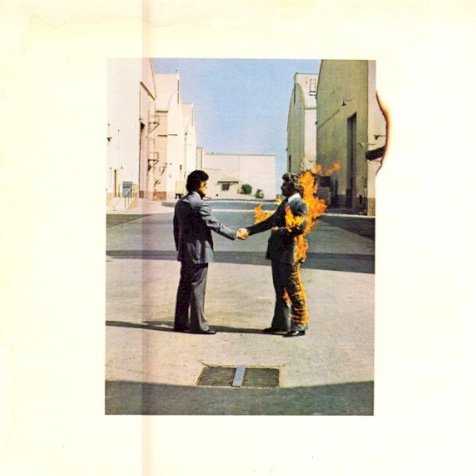 | Album: 10 of 21 Title: Wish You Were Here Released: 1975-09-12 Tracks: 2 Duration: 44:13 Scroll: Up Down Top Bottom 25% 50% 75% Spotify TrackSamples Allmusic AlbumCover | 1 Shine On You Crazy Diamond (Part 1) / Shine On You Crazy Diamond (Part 2) / Shine On You Crazy Diamond (Part 3) / Shine On You Crazy Diamond (Part 4) / Shine On You Crazy Diamond (Part 5) / Welcome to the Machine (21:02) 2 Have a Cigar / Wish You Were Here / Shine On You Crazy Diamond (Part 6) / Shine On You Crazy Diamond (Part 7) / Shine On You Crazy Diamond (Part 8) / Shine On You Crazy Diamond (Part 9) (23:10) |
| Wish You Were Here : Allmusic album Review : Pink Floyd followed the commercial breakthrough of Dark Side of the Moon with Wish You Were Here, a loose concept album about and dedicated to their founding member Syd Barrett. The record unfolds gradually, as the jazzy textures of "Shine on You Crazy Diamond" reveal its melodic motif, and in its leisurely pace, the album shows itself to be a warmer record than its predecessor. Musically, its arguably even more impressive, showcasing the groups interplay and David Gilmours solos in particular. And while its short on actual songs, the long, winding soundscapes are constantly enthralling. | ||
 | Album: 11 of 21 Title: Animals Released: 1977-01-23 Tracks: 5 Duration: 41:30 Scroll: Up Down Top Bottom 25% 50% 75% Spotify TrackSamples Allmusic AlbumCover | 1 Pigs on the Wing, Part One (01:23) 2 Dogs (16:59) 3 Pigs (Three Different Ones) (11:25) 4 Sheep (10:15) 5 Pigs on the Wing, Part Two (01:26) |
| Animals : Allmusic album Review : Of all of the classic-era Pink Floyd albums, Animals is the strangest and darkest, a record thats hard to initially embrace yet winds up yielding as many rewards as its equally nihilistic successor, The Wall. It isnt that Roger Waters dismisses the human race as either pigs, dogs, or sheep, its that hes constructed an album whose music is as bleak and bitter as that world view. Arriving after the warm-spirited (albeit melancholy) Wish You Were Here, the shift in tone comes as a bit of a surprise, and there are even less proper songs here than on either Wish or Dark Side. Animals is all extended pieces, yet it never drifts -- it slowly, ominously works its way toward its destination. For an album that so clearly is Waters, David Gilmours guitar dominates thoroughly, with Richard Wrights keyboards rarely rising above a mood-setting background (such as on the intro to "Sheep"). This gives the music, on occasion, immediacy and actually heightens the dark mood by giving it muscle. It also makes Animals as accessible as it possibly could be, since it surges with bold blues-rock guitar lines and hypnotic space rock textures. Through it all, though, the utter blackness of Waters spirit holds true, and since there are no vocal hooks or melodies, everything rests on the mood, the near-nihilistic lyrics, and Gilmours guitar. These are the kinds of things that satisfy cultists, and it will reward their attention -- theres just no way in for casual listeners. | ||
 | Album: 12 of 21 Title: The Wall Released: 1979-11-30 Tracks: 26 Duration: 1:21:36 Scroll: Up Down Top Bottom 25% 50% 75% Spotify TrackSamples Wikipedia Allmusic AlbumCover | 1 In the Flesh? (03:19) 2 The Thin Ice (02:29) 3 Another Brick in the Wall, Part 1 (03:10) 4 The Happiest Days of Our Lives (01:51) 5 Another Brick in the Wall, Part 2 (04:00) 6 Mother (05:33) 7 Goodbye Blue Sky (02:49) 8 Empty Spaces (02:07) 9 Young Lust (03:32) 10 One of My Turns (03:35) 11 Don’t Leave Me Now (04:16) 12 Another Brick in the Wall, Part 3 (01:17) 13 Goodbye Cruel World (01:14) 1 Hey You (04:44) 2 Is There Anybody Out There? (02:43) 3 Nobody Home (03:26) 4 Vera (01:36) 5 Bring the Boys Back Home (01:27) 6 Comfortably Numb (06:25) 7 The Show Must Go On (01:37) 8 In the Flesh (04:16) 9 Run Like Hell (04:24) 10 Waiting for the Worms (04:00) 11 Stop (00:32) 12 The Trial (05:22) 13 Outside the Wall (01:44) |
| The Wall : Allmusic album Review : The Wall was Roger Waters crowning accomplishment in Pink Floyd. It documented the rise and fall of a rock star (named Pink Floyd), based on Waters own experiences and the tendencies hed observed in people around him. By then, the bassist had firm control of the groups direction, working mostly alongside David Gilmour and bringing in producer Bob Ezrin as an outside collaborator. Drummer Nick Mason was barely involved, while keyboardist Rick Wright seemed to be completely out of the picture. Still, The Wall was a mighty, sprawling affair, featuring 26 songs with vocals: nearly as many as all previous Floyd albums combined. The story revolves around the fictional Pink Floyds isolation behind a psychological wall. The wall grows as various parts of his life spin out of control, and he grows incapable of dealing with his neuroses. The album opens by welcoming the unwitting listener to Floyds show ("In the Flesh?"), then turns back to childhood memories of his fathers death in World War II ("Another Brick in the Wall, Pt. 1"), his mothers over protectiveness ("Mother"), and his fascination with and fear of sex ("Young Lust"). By the time "Goodbye Cruel World" closes the first disc, the wall is built and Pink is trapped in the midst of a mental breakdown. On disc two, the gentle acoustic phrasings of "Is There Anybody Out There?" and the lilting orchestrations of "Nobody Home" reinforce Floyds feeling of isolation. When his record company uses drugs to coax him to perform ("Comfortably Numb"), his onstage persona is transformed into a homophobic, race-baiting fascist ("In the Flesh"). In "The Trial," he mentally prosecutes himself, and the wall comes tumbling down. This ambitious concept album was an across-the-board smash, topping the Billboard album chart for 15 weeks in 1980. The single "Another Brick in the Wall, Pt. 2" was the countrys best-seller for four weeks. The Wall spawned an elaborate stage show (so elaborate, in fact, that the band was able to bring it to only a few cities) and a full-length film. It also marked the last time Waters and Gilmour would work together as equal partners. | ||
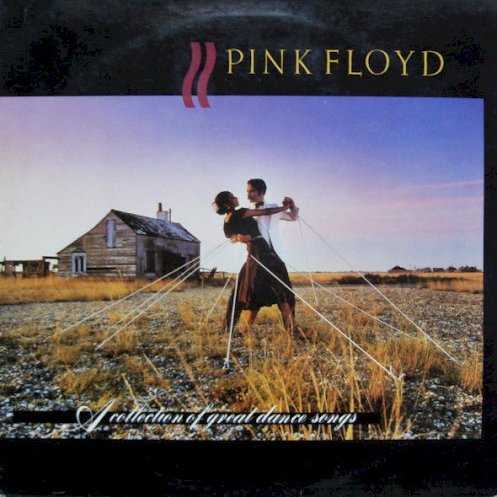 | Album: 13 of 21 Title: A Collection of Great Dance Songs Released: 1981-11-23 Tracks: 6 Duration: 43:01 Scroll: Up Down Top Bottom 25% 50% 75% Spotify Wikipedia Allmusic AlbumCover | 1 One of These Days (05:51) 2 Money (06:49) 3 Sheep (10:20) 4 Shine On You Crazy Diamond (10:58) 5 Wish You Were Here (05:10) 6 Another Brick in the Wall, Part 2 (03:51) |
| A Collection of Great Dance Songs : Allmusic album Review : Anyone who knew anything about Pink Floyd knew that a dance band they were not, so this compilation, courtesy of Columbia Records, was intended ironically. Arguably the quintessential album band, Pink Floyd is not well served by compilations, especially one on which four parts of "Shine on You Crazy Diamond" are edited together and theres a re-recording of "Money." Stick to the full-length versions unless you just want a quick introduction. | ||
 | Album: 14 of 21 Title: Hits Released: 1983 Tracks: 6 Duration: 42:13 Scroll: Up Down Top Bottom 25% 50% 75% Spotify AlbumCover | 1 Shine On You Crazy Diamond (10:40) 2 Wish You Were Here (05:26) 3 Another Brick in the Wall, Part 2 (03:54) 4 The Gunners Dream (05:07) 5 Money (06:45) 6 Sheep (10:21) |
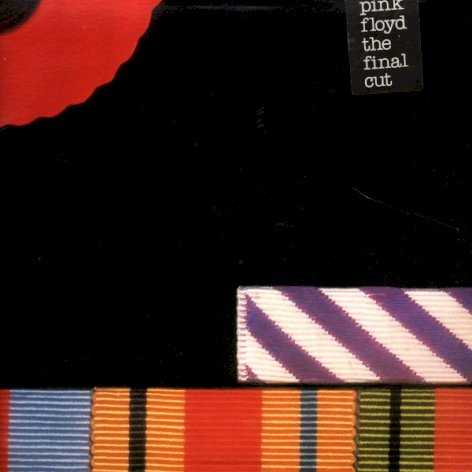 | Album: 15 of 21 Title: The Final Cut Released: 1983-03-21 Tracks: 12 Duration: 43:20 Scroll: Up Down Top Bottom 25% 50% 75% Spotify Wikipedia Allmusic AlbumCover | 1 The Post War Dream (03:02) 2 Your Possible Pasts (04:22) 3 One of the Few (01:22) 4 The Hero’s Return (02:57) 5 The Gunner’s Dream (05:06) 6 Paranoid Eyes (03:42) 7 Get Your Filthy Hands off My Desert (01:16) 8 The Fletcher Memorial Home (04:12) 9 Southampton Dock (02:10) 10 The Final Cut (04:46) 11 Not Now John (05:01) 12 Two Suns in the Sunset (05:20) |
| The Final Cut : Allmusic album Review : The Final Cut extends the autobiography of The Wall, concentrating on Roger Waters pain when his father died in World War II. Waters spins this off into a treatise on the futility of war, concentrating on the Falkland Islands, setting his blistering condemnations and scathing anger to impossibly subdued music that demands full attention. This is more like a novel than a record, requiring total concentration since shifts in dynamics, orchestration, and instrumentation are used as effect. This means that while this has the texture of classic Pink Floyd, somewhere between the brooding sections of The Wall and the monolithic menace of Animals, there are no songs or hooks to make these radio favorites. The even bent of the arrangements, where the music is used as texture, not music, means that The Final Cut purposely alienates all but the dedicated listener. Several of those listeners maintain that this is among Pink Floyds finest efforts, and it certainly is an achievement of some kind -- theres not only no other Floyd album quite like it, it has no close comparisons to anybody elses work (apart from Waters own The Pros and Cons of Hitch Hiking, yet that had a stronger musical core). That doesnt make this easier to embrace, of course, and its damn near impenetrable in many respects, but with its anger, emphasis on lyrics, and sonic textures, its clear that its the album that Waters intended it to be. And its equally clear that Pink Floyd couldnt have continued in this direction -- Waters had no interest in a group setting anymore, as this record, which is hardly a Floyd album in many respects, illustrates. Distinctive, to be sure, but not easy to love and, depending on your view, not even that easy to admire. | ||
 | Album: 16 of 21 Title: Works Released: 1983-06-18 Tracks: 10 Duration: 41:46 Scroll: Up Down Top Bottom 25% 50% 75% Wikipedia Allmusic AlbumCover | 1 One of These Days (05:56) 2 Arnold Layne (02:53) 3 Fearless (Interpolating “You’ll Never Walk Alone”) (05:38) 4 Brain Damage (03:43) 5 Eclipse (02:01) 6 Set the Controls for the Heart of the Sun (05:22) 7 See Emily Play (02:47) 8 Several Species of Small Furry Animals Gathered Together in a Cave and Grooving With a Pict (04:36) 9 Free Four (04:08) 10 Embryo (04:39) |
| Works : Allmusic album Review : 1983s Works is a very bizarre, seemingly random compilation that trudges through the bands first single ("Arnold Layne") to multiple moments from Dark Side of the Moon. Noticing that it selects two songs from one of the best-selling records of all time tells you right off how pointless this is; its a disservice to Pink Floyd and an insult to their fans. Another smack to both band and fan is the inclusion of the well-titled "Embryo," a half-realized demo that was allegedly included on the Harvest labels Picnic compilation from 1970 by accident to begin with. Aside from "Embryo," there isnt anything offered here that a major fan doesnt have. Alternately, someone who doesnt know any better and picks this up as their first Pink Floyd disc is going to get a poor summation of what they did prior to 1975s Wish You Were Here, along with a selection that makes for a bumpy ride. While "Arnold Layne" and "See Emily Play" showcase the bands early brilliance and "One of These Days" (off Meddle) and "Set the Controls for the Heart of the Sun" (off A Saucerful of Secrets) are good examples of their more experimental side, the remainder seems scattershot, as if the catalog department threw darts at a giant corkboard listing the bands songs. Youd get a better introduction by shutting your eyes and purchasing the first thing you grab from the bin that isnt Works or anything from The Final Cut on. Better yet, start with The Piper at the Gates of Dawn and work your way through chronologically. | ||
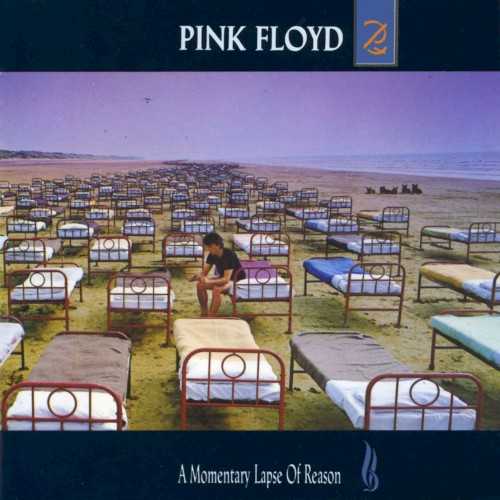 | Album: 17 of 21 Title: A Momentary Lapse of Reason Released: 1987-09-07 Tracks: 10 Duration: 51:13 Scroll: Up Down Top Bottom 25% 50% 75% Spotify Wikipedia Allmusic AlbumCover | 1 Signs of Life (04:24) 2 Learning to Fly (04:53) 3 The Dogs of War (06:05) 4 One Slip (05:10) 5 On the Turning Away (05:42) 6 Yet Another Movie / Round and Around (07:28) 7 A New Machine, Part 1 (01:46) 8 Terminal Frost (06:17) 9 A New Machine, Part 2 (00:38) 10 Sorrow (08:46) |
| A Momentary Lapse of Reason : Allmusic album Review : A David Gilmour solo album in all but name, heavily featuring the kind of atmospheric instrumental music and Gilmour guitar sound typical of the Floyd before the now-departed Roger Waters took over, but lacking Waters unifying vision and lyrical ability. | ||
 | Album: 18 of 21 Title: Shine On Released: 1992-11-09 Tracks: 79 Duration: 6:21:03 Scroll: Up Down Top Bottom 25% 50% 75% Allmusic Wikipedia AlbumCover | 1 Let There Be More Light (05:38) 2 Remember a Day (04:29) 3 Set the Controls for the Heart of the Sun (05:27) 4 Corporal Clegg (04:12) 5 A Saucerful of Secrets (11:57) 6 See‐Saw (04:36) 7 Jugband Blues (03:00) 1 One of These Days (05:56) 2 A Pillow of Winds (05:11) 3 Fearless (06:08) 4 San Tropez (03:43) 5 Seamus (02:15) 6 Echoes (23:32) 1 Speak to Me (01:08) 2 Breathe (02:48) 3 On the Run (03:35) 4 Time (07:04) 5 The Great Gig in the Sky (04:44) 6 Money (06:32) 7 Us and Them (07:40) 8 Any Colour You Like (03:26) 9 Brain Damage (03:47) 10 Eclipse (02:01) 1 Shine On You Crazy Diamond, Parts I–V (13:30) 2 Welcome to the Machine (07:26) 3 Have a Cigar (05:24) 4 Wish You Were Here (05:17) 5 Shine On You Crazy Diamond, Part Two (12:28) 1 Pigs on the Wing, Part 1 (01:25) 2 Dogs (17:04) 3 Pigs (Three Different Ones) (11:28) 4 Sheep (10:20) 5 Pigs on the Wing, Part 2 (01:25) 1 In the Flesh? (03:19) 2 The Thin Ice (02:29) 3 Another Brick in the Wall, Part 1 (03:10) 4 The Happiest Days of Our Lives (01:51) 5 Another Brick in the Wall, Part 2 (04:00) 6 Mother (05:33) 7 Goodbye Blue Sky (02:47) 8 Empty Spaces (02:07) 9 Young Lust (03:32) 10 One of My Turns (03:35) 11 Don’t Leave Me Now (04:16) 12 Another Brick in the Wall, Part 3 (01:17) 13 Goodbye Cruel World (01:14) 1 Hey You (04:41) 2 Is There Anybody Out There? (02:43) 3 Nobody Home (03:26) 4 Vera (01:36) 5 Bring the Boys Back Home (01:27) 6 Comfortably Numb (06:25) 7 The Show Must Go On (01:37) 8 In the Flesh (04:16) 9 Run Like Hell (04:24) 10 Waiting for the Worms (04:00) 11 Stop (00:32) 12 The Trial (05:22) 13 Outside the Wall (01:44) 1 Signs of Life (04:24) 2 Learning to Fly (04:53) 3 The Dogs of War (06:08) 4 One Slip (05:10) 5 On the Turning Away (05:42) 6 Yet Another Movie / Round and Around (07:28) 7 A New Machine, Part 1 (01:46) 8 Terminal Frost (06:17) 9 A New Machine, Part 2 (00:38) 10 Sorrow (08:46) 1 Arnold Layne (02:53) 2 Candy and a Currant Bun (stereo enhanced) (02:46) 3 See Emily Play (02:53) 4 Scarecrow (02:12) 5 Apples and Oranges (stereo) (03:07) 6 Paint Box (03:47) 7 It Would Be So Nice (03:46) 8 Julia Dream (02:35) 9 Point Me at the Sky (03:40) 10 Careful With That Axe, Eugene (05:45) |
| Shine On : Allmusic album Review : This box set devoted to Pink Floyd was somewhat frustrating at the time of its release. Priced at over 100 dollars, it included nine CDs drawn equally from their EMI and Columbia Records, starting with their second album, A Saucerful of Secrets. That seemed to confuse a lot of people who regard that transitional album as a lot less important and alluring than its predecessor, Piper at the Gates of Dawn. On the other hand, EMI was planning its own special edition of that album, and it could be argued that the hardcore fans who might be attracted to this set would certainly already own the debut album, and be prepared to buy EMIs special edition of it. The essential problem is that Pink Floyd, like most prog rock and psychedelic acts of its era, left behind precious few outtakes that would be viable as bonus features for a box such as this. Its not as though they followed too many blind alleys, or left behind multiple versions of, say, "Atom Heart Mother" the way, say, a blues-based band mightve done some rehearsal jams on, say, "Crossroads" or some other standard; most prog rock works sort of stand as they are, and if outtakes do exist, chances are excellent that they never got to the point of getting vocals added. So that all one can really do is upgrade the sound, which was badly needed, and enhance the packaging, and that comes from the hardcover book in the box; and the bonus tracks, courtesy of EMI, come in the form of the ninth CD, titled "The Early Singles," which has proved so popular over the years that its been bootlegged as a real CD (that is, not a CD-R). The book Shine On includes lots of illustrations and even a time line depicting the history around the bands releases, and while it all could have been a little better organized and a bit more ambitious, this is a handy small-scale coffee table book. The flaw lies in the packaging of the box, which is a little flimsy over time in terms of its ability to hold the book and the CDs, and the bonus art. On the other hand, the CDs are sort of packaged to be displayed -- the spine of the eight discs lined up properly on a shelf form the image of the light beam and prism from Dark Side of the Moon. In all, it was the perfect Christmas gift (hence its release in early November) for fanatical Floyd followers, and it still holds up reasonably well. The early singles platter is still a killer collection even if it is the shortest of the discs here, and the rest has its audience, none quite mutually exclusive, and its understandable why some of the rest of their library -- such as the early soundtrack efforts and the live/studio composite Ummagumma -- was left out of what was supposed to be their best profile. And all of the missing works have now been upgraded as well. Indeed, coupled with the special mono and stereo editions of Piper at the Gates of Dawn done around the same time by EMI, this box would, indeed, make the ultimate Pink Floyd experience. | ||
 | Album: 19 of 21 Title: The Division Bell Released: 1994-03-28 Tracks: 11 Duration: 1:05:56 Scroll: Up Down Top Bottom 25% 50% 75% Spotify Allmusic AlbumCover | 1 Cluster One (05:58) 2 What Do You Want From Me (04:21) 3 Poles Apart (07:04) 4 Marooned (05:28) 5 A Great Day for Freedom (04:18) 6 Wearing the Inside Out (06:48) 7 Take It Back (06:12) 8 Coming Back to Life (06:19) 9 Keep Talking (06:11) 10 Lost for Words (05:14) 11 High Hopes (07:58) |
| The Division Bell : Allmusic album Review : The second post-Roger Waters Pink Floyd album is less forced and more of a group effort than A Momentary Lapse of Reason -- keyboard player Richard Wright is back to full bandmember status and has co-writing credits on five of the 11 songs, even getting lead vocals on "Wearing the Inside Out." Some of David Gilmours lyrics (co-written by Polly Samson and Nick Laird-Clowes of the Dream Academy) might be directed at Waters, notably "Lost for Words" and "A Great Day for Freedom," with its references to "the wall" coming down, although the more specific subject is the Berlin Wall and the fall of Communism. In any case, there is a vindictive, accusatory tone to songs such as "What Do You Want From Me" and "Poles Apart," and the overarching theme, from the album title to the graphics to the "I-you" pronouns in most of the lyrics, has to do with dichotomies and distinctions, with "I" always having the upper hand. Musically, Gilmour, Nick Mason, and Wright have largely turned the clock back to the pre-Dark Side of the Moon Floyd, with slow tempos, sustained keyboard chords, and guitar solos with a lot of echo. | ||
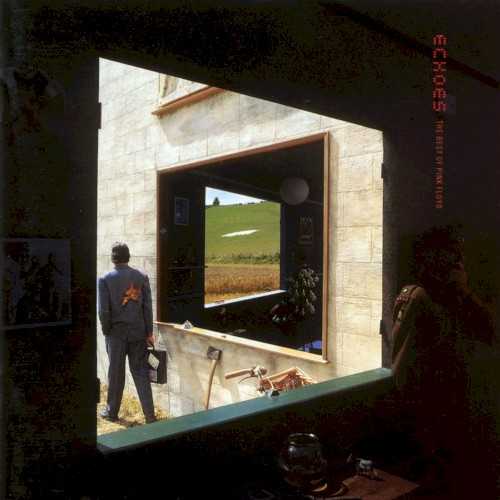 | Album: 20 of 21 Title: Echoes: The Best of Pink Floyd Released: 2001-11-02 Tracks: 26 Duration: 2:35:34 Scroll: Up Down Top Bottom 25% 50% 75% Spotify Wikipedia Allmusic AlbumCover | 1 Astronomy Domine (04:10) 2 See Emily Play (02:47) 3 The Happiest Days of Our Lives (01:38) 4 Another Brick in the Wall, Part 2 (04:00) 5 Marooned (02:02) 6 The Great Gig in the Sky (04:40) 7 Echoes (16:30) 8 Hey You (04:39) 1 Set the Controls for the Heart of the Sun (05:20) 2 Money (06:32) 3 Keep Talking (05:57) 4 Sheep (09:46) 5 Sorrow (08:45) 1 Shine On You Crazy Diamond, Parts 1–7 (17:32) 2 Time (06:48) 3 The Fletcher Memorial Home (04:07) 4 Comfortably Numb (06:53) 5 When the Tigers Broke Free (03:42) 1 One of These Days (05:14) 2 Us and Them (07:51) 3 Learning to Fly (04:53) 4 Arnold Layne (02:53) 5 Wish You Were Here (05:21) 6 Jugband Blues (03:00) 7 High Hopes (06:59) 8 Bike (03:24) |
| Echoes: The Best of Pink Floyd : Allmusic album Review : Being the quintessential album rock band, Pink Floyd hasnt had much luck with "best-of" and "greatest-hits" compilations, like A Collection of Great Dance Songs and the bizarro follow-up, Works. Since both of those were released in the early 80s (and time travel being unavailable even to Pink Floyd), they obviously left out any tracks from the post-Roger Waters era albums. While countless hours in dorm rooms have been spent laboring over whether or not the post-Waters recordings should even be considered the "real Floyd," the later albums nonetheless stand as a further progression in the bands evolution and warrant recognition. The 2001 release Echoes: The Best of Pink Floyd does just that, sequencing the tracks non-chronologically in an effort to place more emphasis on the individual songs as opposed to the era theyre from. Unfortunately, the effect is rather jarring when the songs transition from the clinical mid-90s sound of "High Hopes" directly into the psychedelic groove of the much earlier "Bike." Interestingly, as is the case with most of their albums (but a rarity in "hits" compilations), most of the tracks fade into one another; the hum of "Keep Talking" segueing into the bleating of "Sheep," making for an intriguing listen from one song to the next. There are many highlights on this collection: the inclusion of the Floyd holy grail "When the Tigers Broke Free," a sweeping Waters military dirge that has only appeared in the film The Wall, and the fascinating "Shine on You Crazy Diamond, Pts. 1-7," which has never before been released without the break in the middle (but conspicuously missing parts eight and nine). The confusing inclusion of "The Fletcher Memorial Home" (possibly just to cover something from The Final Cut) and three songs from the decidedly mediocre Division Bell stand out as obvious head-scratchers, making the die-hard Pink Floyd fan wonder if compiler James Guthrie was really clear on what this album should represent. Guthries job was unfortunately doomed from the start; since Pink Floyds strength has always been in the bands rich, sprawling albums, listening to selections cut and chopped from here and there makes it almost like watching three-minute segments from Citizen Kane, Gone With the Wind, and Apocalypse Now, knowing full well that they hold together much better as whole works. Still, Echoes is nearly the best possible assembly of the bands individual songs one could hope for, and collectors and completists should be overjoyed. That being said, anyone just getting into this groups fascinating sound would be much better off starting with Dark Side of the Moon, then working forward, then backward from there: the time honored system of hungrily consuming the Pink Floyd catalog that has stood for generations. | ||
 | Album: 21 of 21 Title: The Endless River Released: 2014-11-07 Tracks: 18 Duration: 52:52 Scroll: Up Down Top Bottom 25% 50% 75% Spotify Wikipedia Allmusic AlbumCover | 1 Things Left Unsaid (04:26) 2 It’s What We Do (06:17) 3 Ebb and Flow (01:55) 4 Sum (04:48) 5 Skins (02:37) 6 Unsung (01:07) 7 Anisina (03:15) 8 The Lost Art of Conversation (01:42) 9 On Noodle Street (01:42) 10 Night Light (01:42) 11 Allons-y (1) (01:57) 12 Autumn ’68 (01:35) 13 Allons-y (2) (01:32) 14 Talkin’ Hawkin’ (03:26) 15 Calling (03:37) 16 Eyes to Pearls (01:51) 17 Surfacing (02:46) 18 Louder Than Words (06:33) |
| The Endless River : Allmusic album Review : David Gilmour sang about an endless river on "High Hopes," the last song on what appeared to be the last Pink Floyd album, 1994s Division Bell. Twenty years later, the same phrase became the title of The Endless River, an album designed as Pink Floyds last. Assembled largely from Division Bell outtakes initially intended as an ambient project dubbed The Big Spliff, the record was sculpted into shape in 2014 by Gilmour, Youth, Andy Jackson, and Roxy Musics Phil Manzanera by adding guitar and Nick Masons drums to original tapes that were laden with keyboards from the late Rick Wright. Hes not the only missing member of Floyd, of course. Roger Waters is absent, as is the long-gone Syd Barrett, but their ghosts are present throughout the primarily instrumental The Endless River. Mortality is on the mind of the two remaining Floyds, mentioned obliquely in "Louder Than Words," the only song with lyrics here, but felt through allusions to all their possible pasts. A song unfurls with washes of synth pulled from "Welcome to the Machine," the four sides are structured like an ongoing amorphous suite à la "Shine on You Crazy Diamond," snippets of Atom Heart Mother slide against guitars that beat to the rhythm from "Run Like Hell," creating an impression of a band in a state of repose: theyre not indulging in their past so much as reflecting on it, watching a tide of memories repeatedly roll in and out. Although very little about The Endless River is risky by design -- it is one of the most popular bands of the 20th century returning to slowly pulsating aural waves that characterized their biggest albums -- the very shift away from vocals realigns the band with not only Wish You Were Here (which this often resembles) but their pre-Dark Side records for Harvest, undercutting the arena-pleasing aspirations of the Gilmour-led reunion while underscoring how Pink Floyd always were an arty band at their core. Instrumentals are also a savvy solution to the trouble of working with uncompleted tapes -- its easier to turn them into an ever-shifting suite than to graft on melodies -- but the comforting sway of swelling synthesizers and the soaring Gilmour guitar are sometimes unexpectedly moving. Gilmour and Mason know this is their farewell, so theyre saying goodbye not with a major statement but with a soft, bittersweet elegy that functions as a canny coda to their career. | ||